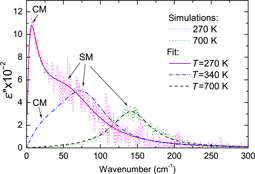Crossref Citations
This article has been cited by the following publications. This list is generated based on data provided by
Crossref.
WANG, DAWEI
WEERASINGHE, JEEVAKA
ALBARAKATI, ABDULLAH
and
BELLAICHE, L.
2013.
TERAHERTZ DIELECTRIC RESPONSE AND COUPLED DYNAMICS OF FERROELECTRICS AND MULTIFERROICS FROM EFFECTIVE HAMILTONIAN SIMULATIONS.
International Journal of Modern Physics B,
Vol. 27,
Issue. 22,
p.
1330016.
Skoromets, V.
Kadlec, C.
Drahokoupil, J.
Schubert, J.
Hlinka, J.
and
Kužel, P.
2014.
Systematic study of terahertz response ofSrTiO3based heterostructures: Influence of strain, temperature, and electric field.
Physical Review B,
Vol. 89,
Issue. 21,
Goian, Veronica
Kamba, Stanislav
Orloff, Nathan
Birol, Turan
Lee, Che Hui
Nuzhnyy, Dmitry
Booth, James C.
Bernhagen, Margitta
Uecker, Reinhard
and
Schlom, Darrell G.
2014.
Influence of the central mode and soft phonon on the microwave dielectric loss near the strain-induced ferroelectric phase transitions inSrn+1TinO3n+1.
Physical Review B,
Vol. 90,
Issue. 17,
Kawayama, Iwao
Kotani, Kenta
Misra, Mukul
Murakami, Hironaru
and
Tonouchi, Masayoshi
2014.
Dielectric properties of (Ba,Sr)TiO3thin films in MHz and THz frequency regions: Quantitative evaluation of the orientational polarization.
Japanese Journal of Applied Physics,
Vol. 53,
Issue. 9S,
p.
09PD06.
Petzelt, J.
Nuzhnyy, D.
Savinov, M.
Bovtun, V.
Kempa, M.
Ostapchuk, T.
Hlinka, J.
Canu, G.
and
Buscaglia, V.
2014.
Broadband Dielectric Spectroscopy of Ba(Zr,Ti)O3: Dynamics of Relaxors and Diffuse Ferroelectrics.
Ferroelectrics,
Vol. 469,
Issue. 1,
p.
14.
Razumnaya, A.G.
Tikhonov, Yu.A.
Yuzyuk, Yu.I.
Zakharchenko, I.N.
Torgashev, V.I.
Ortega, N.
Kumar, A.
Katiyar, R.S.
El Marssi, M.
and
Lukyanchuk, I.A.
2015.
Coexistence of the soft mode and sub-THz central peak in ferroelectric BaTiO3/(Ba,Sr)TiO3 superlattices.
Superlattices and Microstructures,
Vol. 87,
Issue. ,
p.
19.
Dul'kin, Evgeniy
Zhai, Jiwei
and
Roth, Michael
2015.
Relaxor–ferroelectric crossover seen via characteristic temperatures of BaxSr1–xTiO3 ferroelectrics detected by acoustic emission.
physica status solidi (b),
Vol. 252,
Issue. 9,
p.
2079.
Tikhonov, Yu. A.
Razumnaya, A. G.
Torgashev, V. I.
Zakharchenko, I. N.
Yuzyuk, Yu. I.
El Marssi, M.
Ortega, N.
Kumar, A.
and
Katiyar, R. S.
2015.
Emergence of the sub-THz central peak at phase transitions in artificial BaTiO3/(Ba,Sr)TiO3superlattices.
physica status solidi (RRL) - Rapid Research Letters,
Vol. 9,
Issue. 1,
p.
68.
Petzelt, J.
and
Kamba, S.
2016.
Far infrared and terahertz spectroscopy of ferroelectric soft modes in thin films: A review.
Ferroelectrics,
Vol. 503,
Issue. 1,
p.
19.
Hehlen, B.
Al-Sabbagh, M.
Al-Zein, A.
and
Hlinka, J.
2016.
Relaxor Ferroelectrics: Back to the Single-Soft-Mode Picture.
Physical Review Letters,
Vol. 117,
Issue. 15,
Hlinka, J.
Borodavka, F.
Rafalovskyi, I.
Docekalova, Z.
Pokorny, J.
Gregora, I.
Tsurkan, V.
Nakamura, H.
Mayr, F.
Kuntscher, C. A.
Loidl, A.
Bordács, S.
Szaller, D.
Lee, H.-J.
Lee, J. H.
and
Kézsmárki, I.
2016.
Lattice modes and the Jahn-Teller ferroelectric transition ofGaV4S8.
Physical Review B,
Vol. 94,
Issue. 6,
Ji, Jie
Luo, Chunya
Rao, Yunkun
Ling, Furi
and
Yao, Jianquan
2016.
Investigation of optical pump on dielectric tunability in PZT/PT thin film by THz spectroscopy.
Optics Express,
Vol. 24,
Issue. 14,
p.
15212.
Razumnaya, Anna G.
Mikheykin, Alexey S.
Lukyanchuk, Igor A.
Shirokov, Vladimir B.
Golovko, Yury I.
Mukhortov, Vladimir M.
Marssi, Mimoun El
and
Yuzyuk, Yury I.
2017.
Unexpectedly high Curie temperature in weakly strained ferroelectric film.
physica status solidi (b),
Vol. 254,
Issue. 4,
p.
1600413.
Nahas, Y.
Prokhorenko, S.
Kornev, I.
and
Bellaiche, L.
2017.
Emergent Berezinskii-Kosterlitz-Thouless Phase in Low-Dimensional Ferroelectrics.
Physical Review Letters,
Vol. 119,
Issue. 11,
Paściak, M.
Welberry, T. R.
Kulda, J.
Leoni, S.
and
Hlinka, J.
2018.
Dynamic Displacement Disorder of Cubic
BaTiO3.
Physical Review Letters,
Vol. 120,
Issue. 16,
Skjærvø, Sandra H.
Meier, Quintin N.
Feygenson, Mikhail
Spaldin, Nicola A.
Billinge, Simon J. L.
Bozin, Emil S.
and
Selbach, Sverre M.
2019.
Unconventional Continuous Structural Disorder at the Order-Disorder Phase Transition in the Hexagonal Manganites.
Physical Review X,
Vol. 9,
Issue. 3,
Gor’kovaya, E. D.
Tikhonov, Yu. A.
Torgashev, V. I.
Mikheykin, A. S.
Lukyanchuk, I. A.
Mezzane, D.
Ortega, N.
Kumar, A.
Katiyar, R. S.
and
Razumnaya, A. G.
2019.
Properties of the low-frequency phonon spectra of ferroelectric barium titanate-based heterostructures.
Ferroelectrics,
Vol. 543,
Issue. 1,
p.
36.
Marksz, Eric J.
Hagerstrom, Aaron M.
Zhang, Xiaohang
Al Hasan, Naila
Pearson, Justin
Drisko, Jasper A.
Booth, James C.
Long, Christian J.
Takeuchi, Ichiro
and
Orloff, Nathan D.
2021.
Broadband, High-Frequency Permittivity Characterization for Epitaxial
Ba1−xSrxTiO3
Composition-Spread Thin Films.
Physical Review Applied,
Vol. 15,
Issue. 6,
Gu, Fangyuan
Murray, Éamonn
and
Tangney, Paul
2021.
Carrier-mediated control over the soft mode and ferroelectricity in
BaTiO3.
Physical Review Materials,
Vol. 5,
Issue. 3,
Boulbitch, Alexei
and
Korzhenevskii, Alexander L.
2023.
Self-oscillatory instability of the driven phase front propagation induced by liberation of latent heat.
Physical Review E,
Vol. 108,
Issue. 1,



